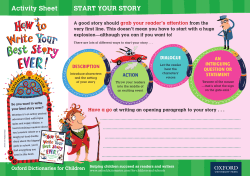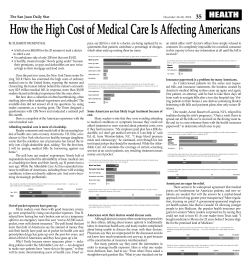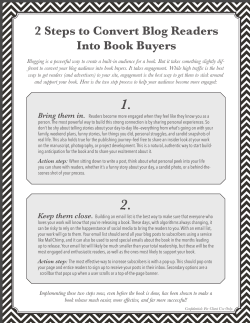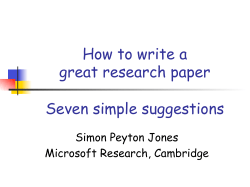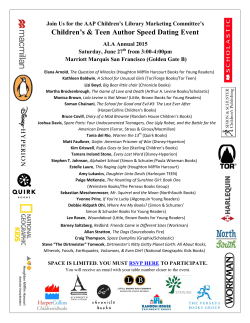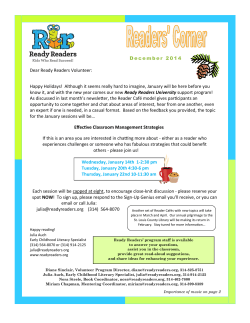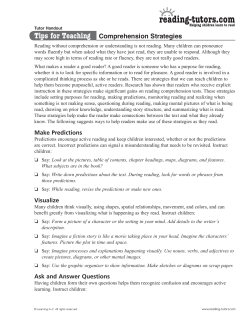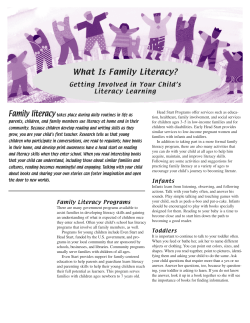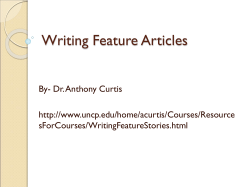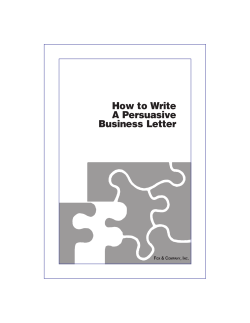
Accelerated Reader: Reading and its Importance: Mead Middle School
Accelerated Reader: Reading and its Importance: Reading is a complicated but invaluable skill. By being a good reader, a student can succeed in almost any class and achieve almost any goal. We know from several important and recent studies that students who read an hour a day have higher grades than those who don’t, score significantly higher on standardized tests, and attend college at a higher rate. With all of this in mind, one of Mead Middle This is our first year of using this nationally-acclaimed, research-based reading program to meet our literacy goals on a building-wide basis. AR has many advantages. It requires students to read on a consistent basis at an appropriate level; it gives students, teachers and parents clear and constructive feedback on the quality of the student’s comprehension; and it offers students a variety of texts to choose from, including fiction and non-fiction and multiple genres. Other Reading Resources at Mead Middle: School’s most important goals is to enable all of our students both to be good readers and to develop a love and respect for reading. Suggestions for Encouraging Independent Reading: - Read a book, then see the movie!! - Sponsor a student book club - Read the paper together, then watch the news - Reward your student for setting and meeting Literacy Lab: Run by Karen Canby, our Literacy Coach, the lab provides students reading below grade level with targeted, individualized reading instruction. Computer Lab and Instructional Media Center: The lab is where most students take their AR quizzes. They can also go to the IMC to take a quiz or find a book. The lab is run by Sherri Platt and Jena Goshia, the IMC by Axel Reitzig and Holli Buchter. Tutoring: Tutoring is available for any student who requests it. Staffed by volunteers, tutoring is provided for students once a week. Holli Buchter coordinates the tutoring program. reading goals! - Regularly visit the library and bookstores, with stops at a cafe Mead Middle School Mead Middle School 620 Welker Ave. Mead, CO 80503 Phone: 970.535.4446 Fax: 970.535.4434 Web: http://www.stvrain.k12.co.us/MEMS/meadhome.html How to Help Your Student Succeed at Reading What Makes for a Successful Reader? Strategies Successful Readers Use One of the challenges of teaching reading is meeting Because adults are so proficient at reading, they forget that the students’ individual needs and cultivating their they are using specific strategies and skills as they read. individual strengths. However, while each reader has The following is a list of the strategies that successful his or her own characteristics, successful readers do readers most often use and suggestions for how you can share several traits. They: help your student develop them: - recognize the value of reading VISUALIZING: Readers create a picture in their mind’s - are able to read different types of materials for different reasons eye as they read by cuing into the author’s descriptive - use different strategies to overcome a variety of difficulties language. TEACH this by pointing out descriptive passages easy to “see”; drawing, cartooning or graphing what they read; modeling visualization by reading out loud and describing what you see as you read; making FINDING RELEVANCE TO PERSONAL LIFE: Students make the following connections as they read: text-text; text-self; and text-world. This helps to clarify and evaluate what has been read, and makes it more meaningful to the students. TEACH this by asking questions like, What does this remind you of? What do you know about this topic? Does this remind you of another book or of a movie? Does this remind you of something you read earlier in the text? MONITORING COMPREHENSION AND USING FIX-UP STRATEGIES: Students need to make sure they know when a text is making sense and when it is not. If they don’t - can self-select materials - are aware of the different resources available to them and graphs. have a sense of what they do and don’t like to read INFERRING (or making a good guess): Students make asking and answering questions to clarify; inferences or read between the lines to interpret meaning recognizing that something is confusing; re-reading; and get the big picture. TEACH inference by asking how explaining how asking for help from a teacher, parent did you know that?; making predictions; and looking at or other student can clarify; and modeling reading of a visual aids and pictures. difficult text. listed above are habits that can be learned, and our QUESTIONING: Students understand a text on a deeper DETERMINING IMPORTANCE AND PURPOSE: literacy program focuses on cultivating them. level because questions clarify confusing passages and - - above all, enjoy reading! While successful readers are born, the really exciting predictions about the story by looking at headings, pictures understand, good readers use strategies to clarify and “fix-up” any confusion. TEACH this by having natural stopping points to self-check for meaning; news is that a good reader can be made! The traits stimulate further interest in a topic. TEACH this by modeling questioning as you read; asking open-ended “I wonder” questions; asking your child to come up with questions before reading, then having him/her answer them as they read; and discussing what questions remain after reading. When students are reading, they have to identify and remember what is important from the material that they read and know why they are reading. TEACH this by having your student write specific questions to answer as they read; evaluating information from a text on a scale of most to least important; and paying attention to visual and textual clues that determine importance.
© Copyright 2025
